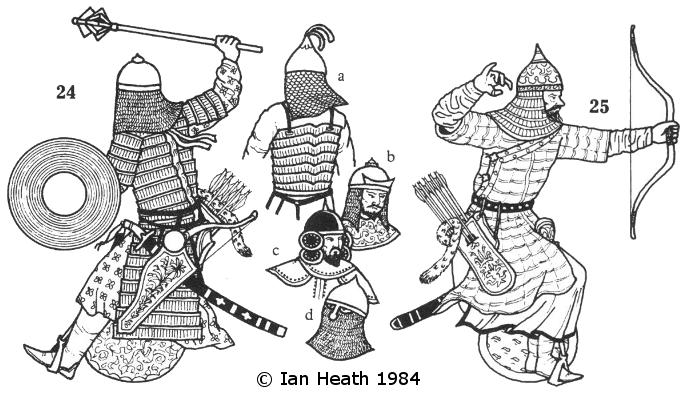PERSIAN CAVALRYMEN c.1335
An extract from Armies of the Middle Ages, Volume 2by Ian Heath


24 & 25. PERSIAN CAVALRYMEN c.1335
Ilkhanid arms production was organised under Ghazan (1295-1304), who saw to it that Iranian craftsmen were taught how to manufacture Mongol-style armour and ordered that the armourers in each town and province were to be paid an annual salary in exchange for producing specific numbers of bows, arrows, quivers, armours and so on, their output increasing in this way from 2,000 to 10,000 armours per annum. The predominant type by the beginning of this period was the khuyagh depicted being worn by figure 24, a lamellar or laminated corselet (the 2 types are often indistinguishable in contemporary pictures) with arm and leg flaps, in the early part of this period often constructed in the form of a long coat. It was mainly of iron, sometimes of bronze, and often enamelled or painted. There were usually openings down the sides (or, less often, the front or back) and a very distinct seam down the middle of the back. Buckles and clasps are depicted very clearly in Raschid al-Din’s mss. of 1306-15.
Throughout most of this period Persian helmets retained much the same form, this being hemispherical with a reinforced brow (often in the form of an upturned peak as in 24b), a plume-tube or spike (later evolving into a tall pointed crown), and either a mail, lamellar or leather aventail or hood, or earguards in the form of 2 or occasionally 3 overlapping discs or flaps (24c). Some had in addition a nasal (24d), which had become movable by the beginning of the 15th century; Clavijo, for instance, describes Persian helmets in 1404 as ‘round and high, and in front a plate, 2 fingers broad, descends as far down as the chin, which can be moved up and down and is intended to protect the face from a sword cut.’
Figure 25 wears a fabric, felt or leather armour called a khatangku dehel (‘coat as hard as steel’) by the Mongols. This could either be worn on its own as here or else under the khuyagh. It may have sometimes been reinforced with small metal plates, stitched between 2 layers of thick fabric brigandine-fashion like the Mamluk karkal (see figure 18, and also 28, 31 and 39). The leopard-tail entwined round the arrows protruding from the quiver of this figure is characteristic of soldiers depicted in Persian mss. of the 14th and early-15th centuries. It was seemingly wound in and out among the arrows in such a way as to stop them from rubbing against one another, which would have damaged the flights, and appeared at least as early as 1306.
Although it is almost invariably the sabre that is depicted in pictures, the sword still occasionally appears alongside it until as late as 1420.